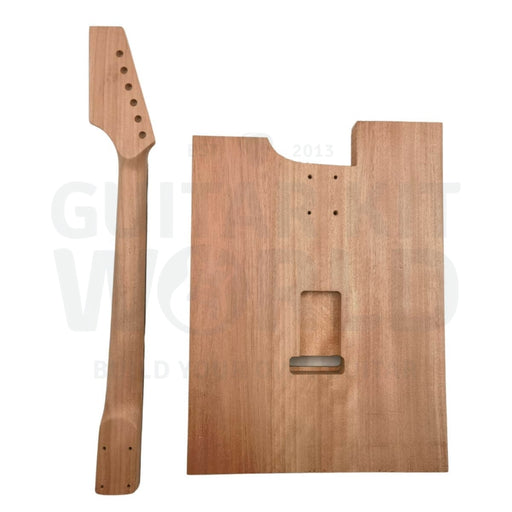Science and Music Collide! STEM Guitar Project
Building a guitar is a great way to combine your love of music and science! Through hands-on experiences, students are able to explore science, math, and technology through the physics of instrument making.
At Southern Arkansas University, students in the ART 4073 course recently brought this idea to life using our blank guitar kits. Over 17 weeks, they shaped blocks of wood into playable, one-of-a-kind instruments now featured in SAU’s Electric Guitar Exhibit — a true celebration of learning through making. Read their story here.

Source: https://photos.saumag.edu/p250553311/h2a457187#h32374db1
In this blog, we will explore this fun STEM project of building your own guitar from a kit. So, if you're interested in combining your love for science and music, or looking for a unique and engaging way to teach STEM subjects, the DIY Guitar Project might be the perfect fit for you!
How DIY Guitar Kits Amplify Essential Skills
Building a DIY guitar offers students a unique opportunity to learn and develop a diverse set of skills, including:
Woodworking and Craftsmanship: Students learn about different types of wood, how to shape and sand the guitar body and neck, and the importance of precision in crafting musical instruments.
Electronics and Soldering: Assembling the electronics of a guitar, such as pickups, volume and tone controls, and input jack, introduces basic electronics and soldering skills.
Problem-Solving and Critical Thinking: Students encounter and must navigate various challenges throughout the building process, enhancing their problem-solving and critical thinking abilities.
Are you an educator aiming to make STEM irresistibly engaging? Transform your classroom with the hands-on adventure of DIY guitar building. Reach out to us for an exclusive educator's discount and let the music of learning begin! Contact us sharing how many students you have and when you want to get started.
Creativity and Design: Customizing the guitar's appearance through painting, staining, and designing allows students to express their creativity and aesthetic sensibilities.
Recommended: Guitar Pyrography: Wood Burning Art
Attention to Detail and Patience: The intricate process of guitar assembly and finishing teaches the importance of attention to detail and patience.
Recommended: Wood carving artwork
Mathematics and Physics: Understanding scale length, fret spacing, action height, and intonation involves mathematical calculations and principles of physics.
Fine Motor Skills: The delicate tasks involved, such as fretwork and setting up the guitar, refine students' fine motor skills and hand-eye coordination.
Project Management: Planning and executing the project from start to finish helps students develop organizational and time-management skills.
Teamwork and Collaboration: Group projects can foster teamwork, communication, and collaborative problem-solving.
Appreciation for Music and Instrumentation: Through building their instrument, students gain a deeper understanding and appreciation for music, the mechanics of sound production, and the craftsmanship behind musical instruments.
Build Your DIY Electric Guitar
Everybody ready? Let's begin the class.
Step 1: Choose Your Guitar Kit
Before you can begin building your guitar, you will need to decide on the design and the guitar kit you want to build.
There are many different Guitar kits to choose from, including solid body designs, semi- hollow body designs, and fully hollow body guitars, so choose one that best fits your interests and skill level. Once you have chosen your design, you will need to prepare Luthier Tools that you will need for this project.
Step 2: Create Your Plan
Once you have your Guitar Kit and Luthier Tools, it's time to get started with your STEM project. This plan will guide you through the building process and ensure that you don't miss any important steps. Be sure to include detailed measurements and visit Guitar Kit World Resources page so that you can stay on track throughout the project.
Step 3: Staining or Painting the Body
The body of the guitar is the most visible part, so you will want to make sure it looks great. This step involves getting your hands dirty with paint, stain or dye, and sandpaper. This is the stage that requires careful sanding and finishing to give the guitar body a smooth and polished appearance.
Painting a guitar body can be a fun and exciting process. It allows builders to personalize their instruments and make them unique to their preferences. Whether it's a solid body or an acoustic guitar, the process of painting a guitar body allows builders to create something special that they can be proud of.
Step 4: Install the Hardware and Electronics
The hardware and electronics are essential components of any guitar, as they allow you to play and adjust the sound of the instrument. This step involves installing the tuning pegs, bridge, pickups, and other components, and wiring them correctly to ensure that the guitar sounds great.
Some guitar builders consider hardware selection to be one of the most critical aspects of the building process. Choosing the right components, such as the bridge, tuners, and pickups, can greatly affect the guitar's playability, tone, and overall feel.

Hardware installation itself is also an important step, and requires attention to detail to ensure proper fit and function of the components. Installing the bridge and pickguard, for example, involves using STEM-related skills and using the appropriate tools in order to finish the task.
Step 5: Set Up and Tune Your Guitar
Once you have completed the building process, it's time to set up and tune your guitar. This involves adjusting the string height, intonation, and other factors to ensure that your guitar plays and sounds great.
Additionally, building a guitar from a kit or modifying an existing one involves understanding the physics of sound and acoustics, as well as the engineering and design aspects of the instrument which again is a great STEM exercise for young adults.
Summary:
Building a guitar is not only a fun and rewarding project, but it's also a great way to develop STEM skills. From designing and measuring to wiring and tuning, this project involves a wide range of scientific and mathematical concepts. So, why not try your hand at building your own guitar today? Have a fun DIY journey.
STEM educators, spark your students' creativity and analytical skills with the exciting project of DIY guitar building. Connect with us to access your special discount and turn your classroom into a studio of innovation and learning.














